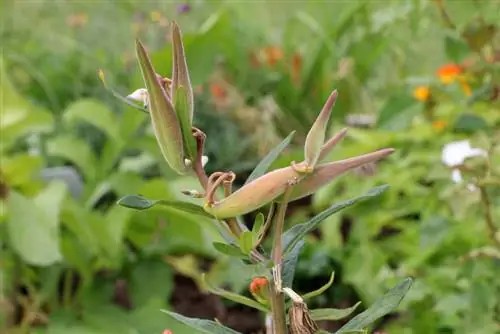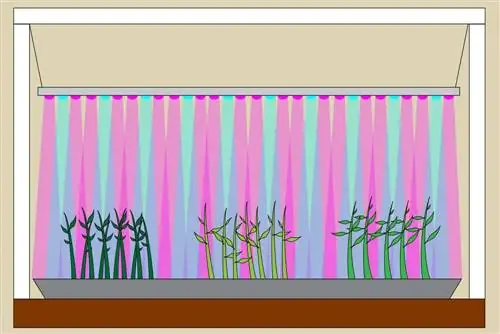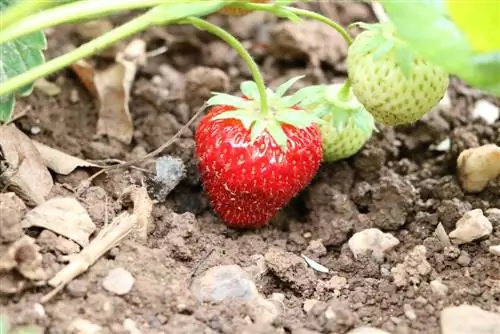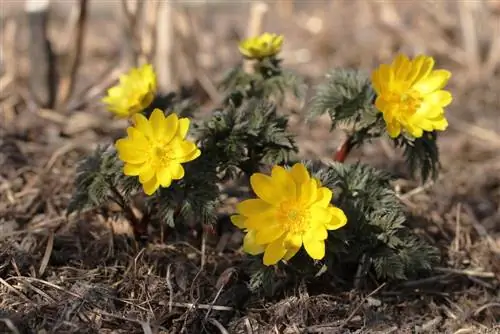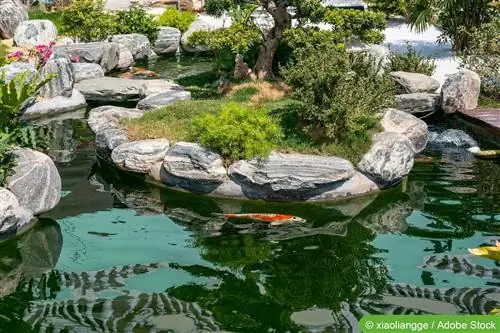- Author admin [email protected].
- Public 2023-12-17 03:39.
- Last modified 2025-01-24 12:45.
The parrot plant, up to 200 cm high, is a real exotic. It grows perennially and becomes more and more attractive every year. Its small purple-pink flowers grow in umbellate inflorescences and exude an intense scent. When the parrot-like fruits burst open in autumn, white, velvety silk threads appear to which the seeds hang, which are then spread through the air.
Location
The common or Syrian milkweed Asclepias syriaca, which comes from North America, finds ideal conditions in sunny and rather dry locations. But it can also find a place in partial shade. However, it usually develops the most beautiful flowers and the intense scent of honey in sunny locations. Due to its tall growth, it should be placed in a place protected from the wind if possible. By the way, the flowering period is from June to August.
Soil texture
Basically, this plant thrives in any well-drained, humus-rich and moderately nutrient-rich garden soil with a slightly acidic to neutral pH value. The soil should be dry rather than too moist. High water permeability is extremely important both in the garden and in the pot or bucket. Standing moisture would inevitably lead to rot and, in the worst case, cause the plant to die. The parrot plant also accepts light clay soils well.
If necessary, elevated planting can be recommended, for example on a slope. This allows rainwater or excess water to drain away better. Soil that is too firm can be loosened by incorporating sand or gravel. When planting in a pot, you should use high-quality soil for flowering plants if possible.
Plants
- It is preferably planted in spring
- In rough locations, planting in pots or buckets is recommended
- When planting in the garden, if possible not without a root barrier
- Parrot plant can otherwise spread uncontrollably via root runners
- Large, bottomless pot, well suited as a root barrier
- Sink the bucket into the ground
- Loosen the soil inside the pot well
- For several plants, maintain a distance of 60-100 cm
- Rake about three plants per square meter
- Root neck should only be minimally below the surface of the soil after planting
- When planting in containers, don't forget a drainage layer made of gravel or pottery shards
- Place a fleece on the gravel and the substrate on top
- After inserting, fill with soil up to just below the edge
- Press down the soil and water well
Tip:
When planting, whether in a bed or a pot, you should proceed very carefully. If shoots are damaged or broken off, initially only the rootstock continues to grow in the soil and new shoots will not appear until the next year.
Care

No matter whether in a bed or a pot, this plant doesn't have any high demands. However, care should be taken to ensure that it does not spread uncontrollably. If it is then watered and fertilized as needed, it is actually satisfied as far as the care is concerned.
Pouring
- Water requirement of this plant is average
- Temporary dryness is better tolerated than too much wetness
- Prolonged drought reduces flowering and shortens flowering time
- Water evenly and regularly in summer
- Preferably with rainwater or well-stale tap water
- Waterlogging must be avoided at all costs
- It's better to avoid saucers and planters for potted plants
- Water could collect in it and cause waterlogging
- Protect the soil in the garden from drying out too much with mulch
Fertilize
In order to optimally supply this plant with nutrients, you can fertilize with compost in May by carefully raking it into the root area. Instead of compost, you can also use horn shavings or cattle manure in the form of pellets. In order to strengthen the plant tissue of planted specimens for overwintering, you can also apply patent potash at the beginning of September.
Specimens in the pot can be supplied with all the important nutrients using a commercially available flowering or liquid fertilizer for potted plants. You fertilize them about every two weeks. Alternatively, you can also use slow-release fertilizer and administer it accordingly.
Cutting
Basically, the parrot plant does not need to be trimmed. Despite everything, young plants in particular are very tolerant of pruning and can be cut back to approx. 25 cm if they are to be reduced a little or branching is to be encouraged. This cut also stimulates flower formation. Disturbing shoots can be easily cut out. The best time for this is in spring. Potted plants can also be trimmed in autumn, for example if they are too large for winter quarters. Older specimens should only be cut a little.
Tip:
The common milkweed belongs to the dog poison family and is considered slightly poisonous, including all parts of the plant and the milky sap it contains. To avoid skin irritation, it is advisable to always wear gloves when cutting.
Propagate
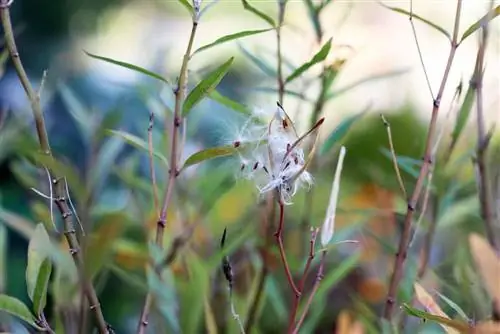
It is no longer possible to purchase Syrian milkweed (Asclepias syriaca) commercially. Since August 2, 2017, neither seeds nor plants of this type may be sold in the EU. The reason for this is that the parrot plant is one of the alien, invasive plants. These are species that were introduced and do not occur here naturally or are not native.
The problem is that they spread uncontrollably via roots and seeds and can thus displace native species. Even if you tear the plants out of the ground, individual pieces of roots always remain in the soil, which then sprout again. That's why the sale is now prohibited by law. If you want to contain or prevent unwanted spread in your home garden, you should, as already mentioned, install a root barrier when planting and remove the fruits in good time so that the plant does not sow itself. Despite everything, you can also propagate the parrot plant manually in your own garden or in a pot, using seeds, cuttings or by division.
Sowing
Seeds for propagation can be obtained from existing plants. Sometimes parrot plant fruits are offered as decoration at weekly markets. With a bit of luck you can use the seeds inside the fruit for sowing. Normally the fruits break open in autumn and a ball of silk oozes out, which is why this plant gets its name milkweed. The small seeds are clearly attached to these fine, silk-like threads.
- Sowing is possible indoors all year round
- Opinions about whether to stratify or not vary
- Stratification (cold treatment) is intended to accelerate germination
- It is best to stratify one part and sow the other directly
- Both methods promising
- To stratify, place seeds in the refrigerator for about a week
- Then sow in pots or bowls
- Cover a maximum of 0.5 to 1 cm with soil
- Moisten the substrate, cover pots with foil or glass
- For ventilation, remove cover briefly daily
- Place the whole thing in a bright, not too warm place
- Temperatures of 16 to 18 degrees are optimal
- First seedlings appear within 2-4 weeks
- Separate from the fourth leaf
Cuttings
Propagation via cuttings is much simpler and uncomplicated, provided you already have a plant from which you can take suitable cuttings, for example when pruning is due. The best time to cut cuttings is from May to August. They should be semi-woody and between 10 and 15 cm long. The lower leaves are removed and the cuttings are placed in small pots with potting soil.
Rooting in a glass of water is also possible, but usually takes a little longer. A translucent foil bag placed over the cutting can accelerate root formation. If the first fresh green appears, this is an indication that the rooting was successful and the film can be removed.
Division
In nature, the parrot plant spreads primarily via runners. New plants continually sprout from the rhizome of these runners, allowing them to colonize larger areas relatively quickly. You can also take advantage of this in your home garden by dividing the plants. Good times for division are both spring and autumn. You dig up the plant with a spade or a digging fork and divide the ball or use individual rhizome pieces or runners for propagation. You then plant both in a semi-shady to sunny spot in the garden or in a pot and water the whole thing.
Parrot Plant Hardiness

The parrot plant Asclepias syriaca, which originally comes from North America, is not entirely hardy in this country, but can tolerate light frosts. It usually survives less cold winters in milder locations well. In winter it goes into a resting phase. The above-ground parts die off and sprout again in spring. Only the roots overwinter in the ground.
- Plants that overwinter outside should be covered from October onwards
- Protect from frost and moisture with leaves, brushwood or compost
- Water moderately on frost-free days
- In rough locations, planting in a container is preferable to outdoor planting
- Overwinter specimens in pots frost-free
- Root balls in the bucket can freeze relatively quickly
- Therefore bright and frost-free, winter at temperatures between 0 and 5 degrees
- Overwintering that is too dark can delay flowering
- Water only sporadically during the winter
- Soil should not dry out completely
- There is no fertilization in winter, neither outside nor inside
Around the end of March, some liquid fertilizer can be administered for the first time and watered more regularly again. The parrot plant can be wintered out again from April. To do this, place them in a sunny place and initially keep them dry. So it should sprout again relatively quickly and bloom profusely. If necessary, it can be repotted into fresh substrate before wintering.
Diseases
Root rot
Diseases are relatively rare with this flowering plant. Despite everything, persistent wetness or waterlogging, for example if watering too much or too often, can lead to rot. Affected plants in the pot can usually only be saved if the infestation is detected early and has not progressed too far. Then you should quickly repot them into a drier substrate and a clean or cleaned pot.
Pests
Aphids
Aphid infestations mainly occur outdoors. A light or initial infestation can often be eliminated or at least minimized by thoroughly rinsing with water. Spraying with a homemade soap solution can also be helpful. The use of natural predators such as ladybird and lacewing larvae or certain species of parasitic wasps has proven successful in many cases.
Wise fly
Whitefly infestations often occur during overwintering when conditions are not optimal. Too much heat in the winter quarters is usually the reason for an infestation. To combat this, you can use commercially available glue boards that are applied according to the manufacturer's instructions. In addition, beneficial insects such as parasitic wasps or ladybird larvae can be used.

